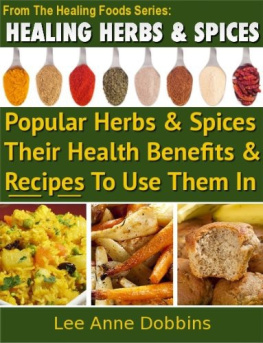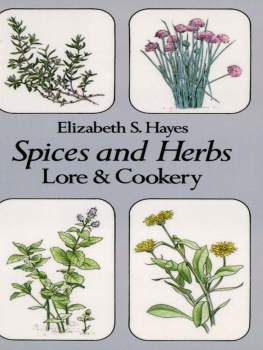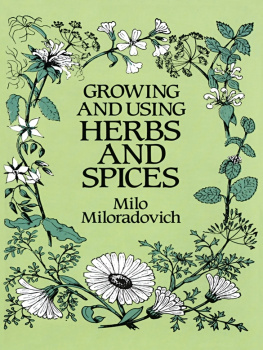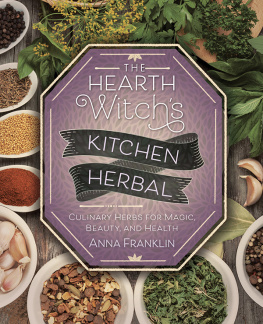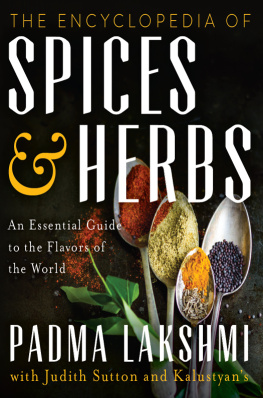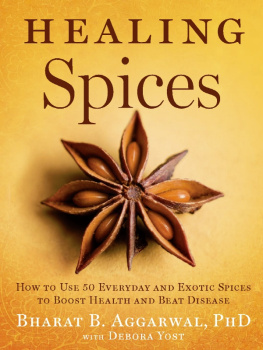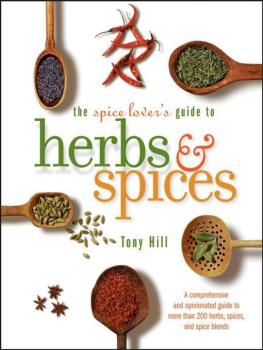Contents
Culinary Herbs and Spices
A Global Guide
Culinary Herbs and Spices
A Global Guide
By
Elizabeth I. Opara
London Metropolitan University, UK
E-mail:
and
Magali Chohan
St Mary's University, UK
E-mail:
Print ISBN: 978-1-83916-156-8
PDF ISBN: 978-1-83916-444-6
EPUB ISBN: 978-1-83916-325-8
A catalogue record for this book is available from the British Library
Elizabeth I. Opara and Magali Chohan 2021
All rights reserved
Apart from fair dealing for the purposes of research for non-commercial purposes or for private study, criticism or review, as permitted under the Copyright, Designs and Patents Act 1988 and the Copyright and Related Rights Regulations 2003, this publication may not be reproduced, stored or transmitted, in any form or by any means, without the prior permission in writing of The Royal Society of Chemistry or the copyright owner, or in the case of reproduction in accordance with the terms of licences issued by the Copyright Licensing Agency in the UK, or in accordance with the terms of the licences issued by the appropriate Reproduction Rights Organization outside the UK. Enquiries concerning reproduction outside the terms stated here should be sent to The Royal Society of Chemistry at the address printed on this page.
Whilst this material has been produced with all due care, The Royal Society of Chemistry cannot be held responsible or liable for its accuracy and completeness, nor for any consequences arising from any errors or the use of the information contained in this publication. The publication of advertisements does not constitute any endorsement by The Royal Society of Chemistry or Authors of any products advertised. The views and opinions advanced by contributors do not necessarily reflect those of The Royal Society of Chemistry which shall not be liable for any resulting loss or damage arising as a result of reliance upon this material.
The Royal Society of Chemistry is a charity, registered in England and Wales, Number 207890, and a company incorporated in England by Royal Charter (Registered No. RC000524), registered office: Burlington House, Piccadilly, London W1J 0BA, UK, Telephone: +44 (0) 207 4378 6556.
For further information see our web site at www.rsc.org
Printed in the United Kingdom by CPI Group (UK) Ltd, Croydon, CR0 4YY, UK
Preface
It was in 2005 that I was asked by a student if I would be interested in supervising their undergraduate research project. The student's name was Magali Chohan, my co-author, who had just completed year 2 of the Nutrition degree at Kingston University. She talked of her eagerness to carry out a project on culinary herbs and spices, an eagerness that stemmed from her use of them in the preparation of food. She went on to talk about the research that had been done which focused on their polyphenol content and antioxidant properties but thought it strange that no one had investigated the impact of cooking on these properties. My research at that time concerned medicinal plants so, along with the fact that I was the Course Director for Kingston's Nutrition programme, I was the obvious choice. I must admit that at the time my interest in culinary herbs and spices did not extend beyond that of most people. When I used rosemary, black pepper, ginger, basil, coriander (leaves or seeds), oregano, sage and/or thyme to prepare lamb, chicken, rice, vegetables, stews and soups I did give not give them much thought beyond ensuring that they enhanced the flavour of the foods I prepared. That meeting fifteen years ago was the start of a not always easy journey one that continues to this day to understand the significance of these foods beyond their flavour enhancing properties with Magali's undergraduate research project spawning other research projects both undergraduate and postgraduate and a number of research publications. Despite our work and the work of other researchers on establishing the significance of culinary herbs and spices in the context of health and disease, writing a book about them was never on my wish list. Yet, when I was contacted by the Royal Society of Chemistry to write a proposal for a book, I jumped at the opportunity to produce a body of work that communicates and reflects the global nature of the research that has and is being done on these foods. I knew I could not do justice to these foods on my own and so asked my long time research collaborator and friend Magali if she would like to get involved; in fact, it was she that put the list of thirty together and came up with the title of the book.
The task was far greater than we had anticipated, as the literature concerning the bioactive properties and purported health benefits for many of culinary herbs and spices we discuss, particularly those used in the Indian subcontinent and the Middle East, is vast. However, we found writing this book extremely educational. I thought I knew a lot about culinary herbs and spices before the book I even dared consider myself an expert but over the time it took to write this book, I learnt so much more about these foods and the work that has been done to understand more fully what role they might play in the maintenance of health, disease prevention and management.
The experience of writing this book was not only one of learning; midway through writing it the pandemic hit and with it came a number of personal and professional challenges. I am, therefore, very happy, proud, and relieved, that Magali and I completed what we set out to do write a global guide on foods that have done more than simply hold our interest for over fifteen years.
Dr Elizabeth Opara
For as long as I can recall I have been passionate about aromatic plants, probably stemming from a childhood spent in rural France, surrounded by a wide variety of plants with memorable scents. I remember twigs of thyme were picked to add flavour to soups as well as to prepare infusions to treat a cold. This interest led me to study part-time courses in Aromatherapy, Herbal Medicine and Nutritional Medicine when I arrived in the UK. These courses enabled me to learn enough English and grasp sufficient foundation in science to obtain a place at university as a mature student with three young children in tow, thanks to the then course director for Nutrition at Kingston University, London, Dr Elizabeth Opara, who was willing to offer me a chance at obtaining an education, for which I am eternally grateful.
Dr Opara had an interest in medicinal plants, so I decided to pitch a specific research project idea concerning the impact of food processing and cooking on the antioxidant properties of a selection of culinary herbs and spices, rather than select one of the undergraduate research topics offered that year. This project idea was not only warmly welcomed and approved but was eventually awarded a first-class grade and successfully published. This then led to the development of my PhD thesis, and my career as an academic, from which further publications and research projects emerged over the past fifteen years.
When Dr Opara was contacted by the Royal Society of Chemistry to write a proposal for a book, she invited me to lunch to discuss the project and offer that I get involved, and I did not hesitate to agree. I now realise that I had a very nave idea of what this would entail, and it became especially challenging through the Covid-19 pandemic, with juggling professional and personal commitments alongside the research for the book. Overall the main difficulty for my sections was in sourcing literature in English (or French) concerning the historical and folk uses of some of the plants outside Western culture, which made me aware of my Eurocentric perspective. However, I am delighted to have contributed to completing this work with my ongoing mentor, Dr Opara, and share with the reader the incredible journey of this selection of culinary herbs and spices, the role these have played in various cultures all over the globe and how they still inspire ongoing high-quality research today.


